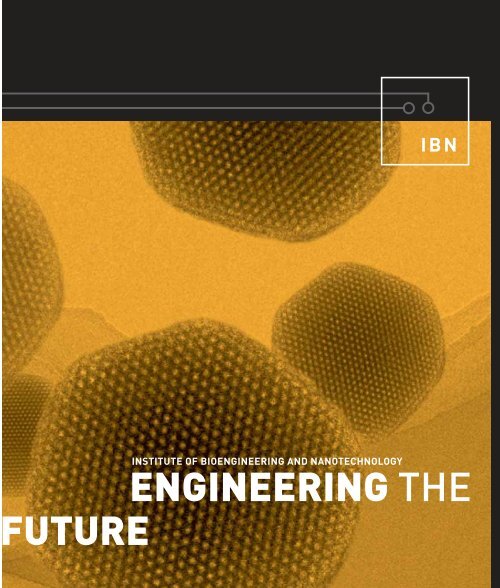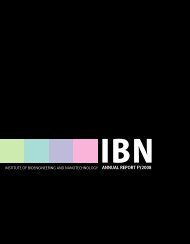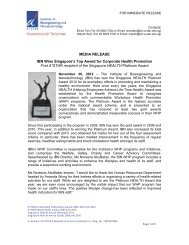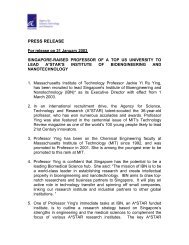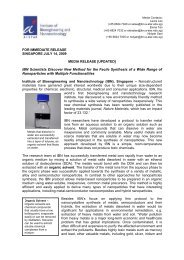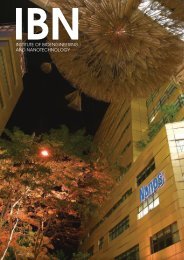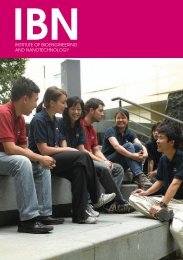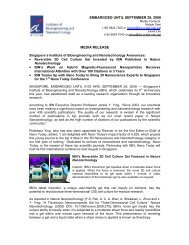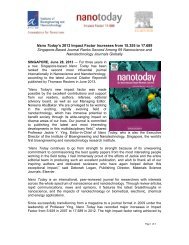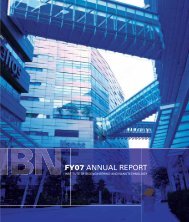IBN - Institute of Bioengineering and Nanotechnology - A*Star
IBN - Institute of Bioengineering and Nanotechnology - A*Star
IBN - Institute of Bioengineering and Nanotechnology - A*Star
You also want an ePaper? Increase the reach of your titles
YUMPU automatically turns print PDFs into web optimized ePapers that Google loves.
<strong>IBN</strong>INSTITUTE OF BIOENGINEERING AND NANOTECHNOLOGYENGINEERING THEUTURE
<strong>IBN</strong>CONTENTS04 ABOUT <strong>IBN</strong>06 EXECUTIVE DIRECTOR'S MESSAGE10 RESEARCH AREAS16 THE NANOS AT BIOPOLIS 18 SCIENTIFIC ADVISORY BOARD20 FACES AT <strong>IBN</strong>24 CAREER OPPORTUNITIES26 YOUTH RESEARCH PROGRAM
<strong>IBN</strong>ABOUT <strong>IBN</strong>ABOUT <strong>IBN</strong>
<strong>IBN</strong> IS A WORLD-CLASS RESEARCHINSTITUTE, WHICH FOCUSES ONDEVELOPING KNOWLEDGE, TALENTAND TECHNOPRENEURSHIP.
04ABOUT <strong>IBN</strong>Established in March 2003, the <strong>Institute</strong> <strong>of</strong> <strong>Bioengineering</strong> <strong>and</strong><strong>Nanotechnology</strong> (<strong>IBN</strong>) aims to create a broad knowledge base <strong>and</strong>conduct innovative research at the interface <strong>of</strong> bioengineering <strong>and</strong>nanotechnology. <strong>IBN</strong> is focused on developing novel technologyplatforms that will spur the growth <strong>of</strong> new industries. We seek t<strong>of</strong>oster an exciting, multidisciplinary research environment to trainstudents <strong>and</strong> young researchers in spearheading the biomedicaladvancement in Singapore.<strong>IBN</strong> is one <strong>of</strong> the 12 research institutes under the Agencyfor Science, Technology <strong>and</strong> Research (A*STAR).
<strong>IBN</strong>EXECUTIVE DIRECTOR'S MESSAGEEXECUTIVEDIRECTOR'S MESSAGE
<strong>IBN</strong> EXECUTIVE DIRECTOR, MIT PROFESSORJACKIE YI-RU YING, WAS HAND PICKED BYA*STAR CHAIRMAN PHILIP YEO TO LEADTHE INSTITUTE.
06EXECUTIVE DIRECTOR'S MESSAGEPROF. JACKIE YI-RU YING
07<strong>Bioengineering</strong> represents the frontiers <strong>of</strong> engineering sciences.The multidisciplinary field has tremendous potential for generatingnew materials, devices, instrumentation <strong>and</strong> processes that wouldimpact healthcare <strong>and</strong> quality <strong>of</strong> life. <strong>Nanotechnology</strong> is a powerfultool that allows us to create <strong>and</strong> manipulate microstructures at thenanometer scale. By integrating nanoscopic <strong>and</strong> macroscopicengineering, we can create novel biomaterials <strong>and</strong> medical deviceswith unique functionalities that mimic biological systems.The <strong>Institute</strong> <strong>of</strong> <strong>Bioengineering</strong> <strong>and</strong> <strong>Nanotechnology</strong> (<strong>IBN</strong>) was established in 2003 toexploit the tremendous opportunities presented at the interface <strong>of</strong> these two excitingfields. By establishing <strong>and</strong> targeting the latest scientific <strong>and</strong> engineering approachesfor biomedical technologies, we have carved a niche in the development <strong>of</strong> knowledge,intellectual property <strong>and</strong> talent. In particular, we have converged multiple disciplinesacross engineering, science <strong>and</strong> medicine to build our six areas <strong>of</strong> research:DELIVERY OF DRUGS, PROTEINS AND GENESNANOBIOTECHNOLOGYTISSUE ENGINEERING<strong>IBN</strong>BIOLOGICAL AND BIOMEDICAL IMAGINGARTIFICIAL ORGANS AND IMPLANTSMEDICAL DEVICES
08EXECUTIVE DIRECTOR'S MESSAGEBy combining the knowledge <strong>and</strong> tools available in each <strong>of</strong> these six research areas,we have also charted new directions for research.<strong>IBN</strong>’s interdisciplinary research approach is carried out by scientists who have beenrecruited from top institutions around the world. We work in an open <strong>and</strong> vibrantresearch environment, where each researcher is encouraged to tap on the expertise<strong>of</strong> their fellow colleagues. This creates a fluid exchange <strong>of</strong> ideas across the differentresearch groups, <strong>and</strong> allows scientists to thrive creatively.These are also the same scientists who are getting our young people excited aboutresearch. Our Youth Research Program features activities to involve students <strong>of</strong> allages, as well as their teachers. We hope the passion <strong>and</strong> excitement shown by ourscientists will influence students to make research their career goal.As we steadily move towards our full staff strength <strong>of</strong> 250, we hope to make asignificant impact both locally <strong>and</strong> internationally with our young <strong>and</strong> dynamic team<strong>of</strong> researchers <strong>and</strong> staff.Research is all about breaking old barriers <strong>and</strong> establishing new frontiers – <strong>and</strong> <strong>IBN</strong>looks forward to setting many benchmarks in the years ahead.PROF. JACKIE YI-RU YINGEXECUTIVE DIRECTORINSTITUTE OF BIOENGINEERING AND NANOTECHNOLOGY
<strong>IBN</strong>RESEARCH AREASRESEARCH AREAS
<strong>IBN</strong> SPEARHEADS THE ADVANCEMENT OFKNOWLEDGE AND INNOVATION AT THE INTERFACEOF BIOENGINEERING AND NANOTECHNOLOGY.
10RESEARCH AREAS
11DELIVERY OF DRUGS, PROTEINS AND GENES <strong>IBN</strong> researchers are designing innovative materials<strong>and</strong> devices for greater precision <strong>and</strong> control in drug delivery, thereby improving therapeutic efficiency<strong>and</strong> minimizing side-effects. For example, nanoparticles are engineered with functionalized moieties thatrespond to physiological or externally applied stimuli, hence allowing for specific targeting <strong>of</strong> tissues inthe body. By encapsulating doxorubicin or paclitaxol in these nanoparticles, intracellular doxorubicin orpaclitaxol release in tumor cells can be achieved. Researchers are also fabricating nanostructuredmembranes with cell attachment <strong>and</strong> thermosensitive-swelling properties for use as wound dressing oras a support for cell grafting. This nanomaterial can be adapted for use as therapeutic contact lenses forocular drug delivery. Other research areas include the development <strong>of</strong> biocompatible <strong>and</strong> biodegradableinjectable hydrogels for localized delivery <strong>of</strong> therapeutic agents <strong>and</strong> cells, as well as novel gene deliveryvectors to enhance the treatment <strong>of</strong> neurological illnesses such as Alzheimer’s <strong>and</strong> Parkinson’sdiseases.TISSUE ENGINEERING Severe donor shortages worldwide result in an ever-pressing need for viablesubstitutes for organs or tissues that are lost or damaged through trauma or disease. <strong>IBN</strong> researchersare growing replacement tissues for liver <strong>and</strong> kidney implants ex viv ex vivo by seeding cells on scaffoldscontaining growth factors. 3-D extracellular microenvironments, novel hydrogels, matrices, micro- <strong>and</strong>nano-scaffolds, as well as microencapsulation technologies are developed to enhance <strong>and</strong> maintain thefunctions <strong>of</strong> mammalian cells such as hepatocytes, neurons <strong>and</strong> stem cells. Research on vitrification <strong>and</strong>engineering <strong>of</strong> cells <strong>and</strong> tissues also focuses on developing high-throughput cryopreservation to facilitateresearch, storage <strong>and</strong> transport <strong>of</strong> sensitive cells, celluloids <strong>and</strong> tissues. Through sophisticated materialsarchitecture, biodegradable <strong>and</strong> biocompatible microbraided polymeric fibers with tissue-compatiblemechanical properties <strong>and</strong> surface reactivity are fabricated for use as nerve guide conduits in nerveregeneration. These fibers incorporate controlled release <strong>of</strong> neurotrophic factors, gene delivery <strong>and</strong> cellseeding for successful tissue regeneration.
12RESEARCH AREAS
13ARTIFICIAL ORGANS AND IMPLANTS Research in this area involves engineering structures for useas artificial organs <strong>and</strong> implants. For orthopedic implants, <strong>IBN</strong> researchers are developing simplebioprocesses to generate natural bone scaffolds. The resulting anorganic porcine bone greatly facilitatesbone remodelling. Nanocomposite foams have also been reconstituted from natural ingredients <strong>of</strong> bone.Using highly porous, sponge-like collagen matrix <strong>and</strong> apatite nanocrystals, <strong>IBN</strong> has achieved boneimplant materials that are structurally <strong>and</strong> chemically similar to natural bone, <strong>and</strong> highly bioactive withtunable mechanical properties <strong>and</strong> degradation rates. The <strong>Institute</strong> also conducts research in the areas <strong>of</strong>dental <strong>and</strong> cochlear implants, <strong>and</strong> seeks to develop flexible systems that can be adjusted to fit therequired defect length. Such implants could also be combined with bioactive compounds <strong>and</strong> drug or genedelivery systems to provide restorative functions <strong>and</strong> promote implant integration.MEDICAL DEVICES <strong>IBN</strong> integrates micr<strong>of</strong>abrication, micr<strong>of</strong>luidics <strong>and</strong> nanotechnology to develop novelmedical devices, such as biosample preparation <strong>and</strong> analysis systems, <strong>and</strong> endovascular microtools forminimally invasive surgery. A micr<strong>of</strong>luidic device has also been developed to study cell migration <strong>and</strong>deformation behavior for cancer research. <strong>IBN</strong> researchers are also working on wearable, implantable<strong>and</strong> injectable devices. Examples in these areas include smart shirts with microaccelerometers for falldetection, wireless devices to detect <strong>and</strong> diagnose bruxism, advanced aerosol inhalation devices to treatinfant asthma, telemetry-based implantable systems for electronically controlled drug release, as well asmicroneedle arrays for painless transdermal drug delivery. <strong>IBN</strong> researchers are also studying discretenanostructures to fabricate gecko-mimicking tape <strong>and</strong> infrared detectors. In addition, the <strong>Institute</strong> isworking on bi<strong>of</strong>ilm prevention <strong>and</strong> elimination.BIOLOGICAL AND BIOMEDICAL IMAGING <strong>IBN</strong> specializes in the molecular <strong>and</strong> microscopic imaging<strong>of</strong> medical systems, biomaterials, biologics, tissues <strong>and</strong> cells. Imaging is also used as a tool for cellculture <strong>and</strong> in vitro studies that are critical for testing the viability <strong>and</strong> biocompatibility <strong>of</strong> novel materials<strong>and</strong> medical devices. In addition, small animal imaging is pursued at <strong>IBN</strong> to facilitate in vivo studies. Theinstitute conducts research in advanced imaging techniques such as multiphoton microscopy, combinedconfocal <strong>and</strong> atomic force microscopy, <strong>and</strong> optical coherence tomography. It also develops novel imagingtags with interesting optical <strong>and</strong> magnetic properties, such as water-soluble quantum dots, <strong>and</strong>bioconjugated oxide <strong>and</strong> metallic nanoparticles.
14RESEARCH AREASNANOBIOTECHNOLOGY In the multibillion-dollar chiralpharmaceuticals industry, the manufacture <strong>of</strong> chiralingredients account for 10–40% <strong>of</strong> the total cost due to theinefficient, energy-intensive batch processes involved. <strong>IBN</strong>is focusing on improving the efficiency <strong>of</strong> chiralpharmaceuticals synthesis <strong>and</strong> separation through the use <strong>of</strong>novel heterogenized catalysts <strong>and</strong> separation media.Supramolecular templating is employed to generate novelnanoporous supports that can immobilize chiral lig<strong>and</strong>s forenantioselective catalysis <strong>and</strong> separation. This would providethe possibility <strong>of</strong> replacing the conventional batch reactionswith continuous processes for pharmaceuticals synthesis. <strong>IBN</strong>is also conducting research on the biosensing <strong>of</strong> tracebiomolecules. For example, nanostructured materials aredesigned as ultrasensitive biosensors for nucleic acids. Anarray <strong>of</strong> such biosensors is further combined with a bio-MEMStissue h<strong>and</strong>ling system to provide fast <strong>and</strong> accurate diagnosis<strong>of</strong> diseases at an early stage.
<strong>IBN</strong>AT BIOPOLISTHE NANOSTHE NANOS AT BIOPOLIS
<strong>IBN</strong> IS DEDICATED TO PROVIDINGITS RESEARCHERS WITH THE BESTENVIRONMENT ANDSTATE-OF-THE-ART FACILITIES.
16THE NANOS AT BIOPOLISHoused over six floors at The Nanos, <strong>IBN</strong> is strategically located within Biopolis, aworld-class biomedical sciences R&D hub in Asia. The modern billion-dollar complex<strong>of</strong>fers researchers first-rate infrastructure <strong>and</strong> a conducive environment, whichenables them to focus on the creative development process. The state-<strong>of</strong>-the-artfacilities available at Biopolis include animal research facilities, conference rooms<strong>and</strong> laboratory support services. With key government agencies, various R&D labs <strong>of</strong>pharmaceutical <strong>and</strong> biotech companies, as well as public research institutes <strong>and</strong>academic institutions within close proximity <strong>of</strong> each other, Biopolis aims to foster acollaborative culture among the private <strong>and</strong> public research communities.
<strong>IBN</strong>SCIENTIFIC ADVISORY BOARDSCIENTIFICADVISORY BOARD
<strong>IBN</strong>’S INTERNATIONAL ADVISORY BOARD MEMBERS ARELEADING EXPERTS IN VARIOUS DISCIPLINES.
18SCIENTIFIC ADVISORY BOARD01 KENNETH A. SMITH (CHAIR)EDWIN R. GILLILAND PROFESSOR OF CHEMICAL ENGINEERINGMASSACHUSETTS INSTITUTE OF TECHNOLOGY02 GALEN D. STUCKY (CO-CHAIR)PROFESSOR OF CHEMISTRY AND MATERIALSUNIVERSITY OF CALIFORNIA, SANTA BARBARA03 JAMES R. HEATHELIZABETH W. GILLOON PROFESSOR OF CHEMISTRYCALIFORNIA INSTITUTE OF TECHNOLOGYPROFESSOR OF MOLECULAR AND MEDICAL PHARMACOLOGYUNIVERSITY OF CALIFORNIA, LOS ANGELES04 KLAVS F. JENSENLAMMOT DU PONT PROFESSOR OF CHEMICAL ENGINEERINGAND MATERIALS SCIENCE AND ENGINEERINGMASSACHUSETTS INSTITUTE OF TECHNOLOGY0102 03 040505 MYRON SPECTORPROFESSOR OF ORTHOPEDIC SURGERYHARVARD MEDICAL SCHOOLDIRECTOR OF ORTHOPEDIC RESEARCHBRIGHAM AND WOMEN'S HOSPITAL
<strong>IBN</strong>FACES AT <strong>IBN</strong>FACES AT <strong>IBN</strong>
<strong>IBN</strong> RECRUITS THE BEST TALENTS FROMAROUND THE WORLD TO MAKE UP ITSYOUNG AND DYNAMIC WORKFORCE.
20FACES AT <strong>IBN</strong>S T SELVAN SENIOR RESEARCH SCIENTIST“There is a lot <strong>of</strong> scope for researchers at <strong>IBN</strong>, as the <strong>Institute</strong> brings together expertisefrom various disciplines under one umbrella to meet the needs <strong>of</strong> bioengineering <strong>and</strong>nanotechnology research. <strong>IBN</strong> is the only institute today that hubs these two emergingfields for the benefit <strong>of</strong> society. The <strong>Institute</strong>’s environment facilitates the generation <strong>of</strong>new ideas <strong>and</strong> challenges one to turn them into reality. Singapore is also a great place todo research. I am fascinated by the country's rich culture <strong>and</strong> my family feels very muchat home here, not only because <strong>of</strong> Singapore's proximity to India but also because <strong>of</strong>'Little India'."CHUNG JOO EUN RESEARCH SCIENTIST“<strong>IBN</strong> is one <strong>of</strong> the most forward-looking <strong>and</strong> dynamic researchinstitutes in the world. The great facilities reflect the strongcommitment <strong>of</strong> the Singapore government in supporting research<strong>and</strong> development activity in this field. <strong>IBN</strong>’s multidisciplinaryresearch environment also <strong>of</strong>fers exciting opportunities forsynergy <strong>and</strong> collaboration.”
21LANG ZHUO PRINCIPAL RESEARCH SCIENTIST“I had worked in both academic <strong>and</strong> industrial settings in the US before I joined <strong>IBN</strong> last year. IfSingapore is a gateway city state, <strong>IBN</strong> would be a gateway research institute, where I have ampleopportunities to propose <strong>and</strong> to work on interesting projects, starting from basic research with thepotential to go all the way to commercialization. As a Principal Research Scientist, one <strong>of</strong> the obviousadvantages <strong>of</strong> working at <strong>IBN</strong> is the fact that I do not need to spend a quarter <strong>of</strong> my preciousresearch time on writing lengthy research grants to seek funding.”KARL MARIA SCHUMACHER SENIOR RESEARCH SCIENTIST“I find it fascinating to work on a tissue engineering project that aims to help surgeons restore a diseased organ. <strong>IBN</strong>is one <strong>of</strong> the few places in the world where this ambitious aim can be realized. I’m convinced that <strong>IBN</strong>’s strategy tomerge basic research <strong>and</strong> commercial application through multidisciplinary research will set trends for otherresearch institutions around the world. <strong>IBN</strong>’s modern infrastructure <strong>and</strong> facilities inspires one to perform first-classresearch. On another note, I like Singapore’s exotic vegetation <strong>and</strong> high living st<strong>and</strong>ards. In particular, it provides myfamily with a safe living environment.”
22FACES AT <strong>IBN</strong>SHONA PEK SENIOR LAB OFFICER“I was assigned to <strong>IBN</strong> after my scholarship. The institute gives me a greatdeal <strong>of</strong> freedom <strong>and</strong> independence to work on my own research projects.We also have a very active Youth Research Program. I get to mentorstudents who are really interested <strong>and</strong> enthusiastic, <strong>and</strong> it is mostrewarding <strong>and</strong> fulfilling working with them <strong>and</strong> teaching them what I know.Singapore is a great place to live, <strong>and</strong> I really enjoy working at <strong>IBN</strong>.”FRANK ALEXIS POSTDOCTORAL FELLOW“For me, <strong>IBN</strong>’s main attraction is its challenging environment. Projects are exciting<strong>and</strong> we receive tremendous resources <strong>and</strong> support from the institute to help usachieve our objectives. In addition, I enjoy interacting with <strong>and</strong> learning from peoplewho come from different backgrounds, such as medical doctors, chemists, biologists<strong>and</strong> materials engineers. The unique environment at <strong>IBN</strong> makes it possible for us todo the best research work.”EMRIL ALI A*STAR GRADUATE SCHOLAR"<strong>IBN</strong> is a cultural melting pot. The <strong>Institute</strong>’s multidisciplinary researchenvironment gives me the opportunity to not only work with researchersfrom various fields but also interact with people from different parts <strong>of</strong> theworld. Coupled with first-rate research facilities, <strong>IBN</strong> provides the idealenvironment for me to do my PhD research."
<strong>IBN</strong>CAREERCAREER OPPORTUNITIESOPPORTUNITIES
<strong>IBN</strong> WELCOMES INDIVIDUALS WITH A PASSIONFOR INNOVATION TO JOIN THE INSTITUTE.
24CAREER OPPORTUNITIES0102030405DR YU HANPOST-DOCTORAL FELLOWDR JEROME BOULAIRERESEARCH SCIENTISTSHARON OHSENIOR LAB OFFICERDR SU SEONG LEESENIOR RESEARCH SCIENTISTDR CYRUS PAPANSENIOR RESEARCH SCIENTIST01 0203 0405<strong>IBN</strong> is on the lookout for highly motivatedindividuals, who are interested in joininga multidisciplinary research institute atthe forefront <strong>of</strong> bioengineering <strong>and</strong>nanotechnology research. C<strong>and</strong>idatescan expect competitive salaries, as wellas attractive benefits.For more details on career opportunitieswith <strong>IBN</strong>, visitwww.ibn.a-star.edu.sg.Interested c<strong>and</strong>idates may also emailtheir resumes tojyying@ibn.a-star.edu.sg.
<strong>IBN</strong>YOUTH RESEARCHPROGRAMYOUTH RESEARCH PROGRAM
<strong>IBN</strong> AIMS TO INSPIRE BRIGHT YOUNG MINDSTO PURSUE THEIR SCIENTIFIC INTERESTS.
26YOUTH RESEARCH PROGRAM
27The brainchild <strong>of</strong> <strong>IBN</strong>’s Director, Noreena AbuBakar, the <strong>Institute</strong>’sYouth Research Program aims to expose our young people to ourdynamic research culture. The program is designed to give studentsfirst-h<strong>and</strong> experience in research <strong>and</strong> help teachers introducebioengineering <strong>and</strong> nanotechnology applications into their schoolcurriculum.NOREENA ABUBAKAR“It is never too early to expose the young to science. By sharing ourenthusiasm for making an impact on our society through scientificdiscoveries, we hope that we will be able to inspire more young peopleto pursue research careers.”NOREENA ABUBAKARDIRECTOR, INSTITUTE OF BIOENGINEERING AND NANOTECHNOLOGYCHAIR, YOUTH RESEARCH PROGRAM
28YOUTH RESEARCH PROGRAMSince its launch in October 2003, <strong>IBN</strong>’s Youth ResearchProgram has reached out to more than 2,500 students<strong>and</strong> teachers from over 50 primary <strong>and</strong> secondaryschools, junior colleges, polytechnics <strong>and</strong> universities.<strong>IBN</strong>’s Youth Research Program activities includecareer fairs <strong>and</strong> talks, Open Houses, as well asresearch attachments for teachers <strong>and</strong> students.Contact yrp@ibn.a-star.edu.sgfor more information.
A * STAR<strong>Institute</strong> <strong>of</strong><strong>Bioengineering</strong> <strong>and</strong><strong>Nanotechnology</strong>www.ibn.a-star.edu.sg


